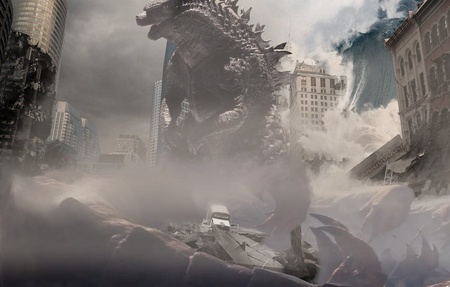Although Hollywood has been making monster movies since the original 1933 King Kong, the monster with the most staying power and screen incarnations didn’t come out of California, but from Tokyo.
Godzilla is back with another cinematic reboot produced by Hollywood featuring the usual array of mega-special effects, including a digitized monster instead of a man in a monster suit.
Whether costumed or computer-generated, Godzilla is the most famous Japanese American in the world. He’s starred in 28 movies, stomping his way through cities on both sides of the Pacific.
Godzilla, or the Japanese pronunciation, “Gojira” (a combination of the words for gorilla, “gorira” and whale, “kujira”) made its first Japanese appearance 60 years ago, in 1954, but the film was edited and scenes inserted starring Raymond Burr as an American journalist for its 1956 release in the U.S. as Godzilla, King of the Monsters!
I always thought this was to make the movie more palatable to American audiences, but now I realize there was a more political reason for the reworking of the first film.
In the decades since then, Godzilla/Gojira has battled a bevy of equally monstrous baddies, such as Mothra, Gaigan, Hedora, Mechagojira, and yes, even King Kong. There was a millennium edition Godzilla in 2000 that destroyed Nemuro, my mom’s hometown. And in 2004, Toho allegedly put the monster to rest for good in Godzilla Final Wars. But Godzilla is good business, apparently.
All of the movies in the franchise were produced by Toho, the Japanese studio, except for the 1998 Hollywood take, the first time the monster was created digitally instead of the traditional Japanese approach of a guy wearing a rubber lizard suit. Toho co-produced that one, and the studio also profits from the new Warner Brothers-produced movie, and is distributing it in Japan.
I have the 1956 version with Burr, and like it because it’s more of a serious movie than the campy approach most of the movies have taken over the years. It’s an unabashed statement, created early in the post-war atomic age that reflects Japan’s terror at the U.S. and other countries’ testing of atomic bombs in the Pacific. The original film’s clear message is that if you mess with Mother Nature, Mother Nature will mess with you right back.
That original 1956 version of Godzilla, King of the Monsters! has been re-released in the U.S. in a two-DVD set that includes the original, longer Japanese version, which is more upfront about its anti-nuclear message. The New York Times wrote about the 2006 DVD release:
“Generations of critics who have congratulated themselves on decoding the pacifist, antinuclear message of ‘King of Monsters’ will be startled by the explicitness of the Japanese version, in which Gojira (as the Japanese transliterate his name) is repeatedly identified as a result of testing in the Pacific and the embodiment of the nation’s nuclear trauma.
“Images of a devastated miniature Tokyo (quite effective in black and white) have clearly been modeled on the newsreels of Hiroshima and Nagasaki, and the film concludes with the kindly scientist solemnly declaring, ‘If we keep on conducting nuclear tests, it’s possible that another Godzilla might appear, somewhere in the world, again.’”
This was one of the lines cut from the movie for American audiences, which was being primed in the mid-1950s by the U.S. government to accept nuclear power as the future, and a necessity in the growing paranoid fight against the Russkies and their atomic arsenal. Maybe the movie was recut and Burr’s parts inserted for mere entertainment reasons, to appeal to an American audience.
But maybe it was done to keep Americans complacent and in the dark. In a way, that makes Godzilla even scarier, doesn’t it? In post-Fukushima Japan, where people are once again jittery about the dangers of nuclear energy, the message at the core of Godzilla resonates with fresh urgency.
The 2014 reboot, Godzilla opened May 16 in America and internationally, and the monster is showing some serious staying power. In its opening weekend, the film grossed $93.2 million in the U.S. and $103.4 million around the globe, not including japan.
The new film won’t open in Japan until July. But the early reaction in the monster’s home country seems to be mockery and ridicule, that this Japanese export has now become too Americanized. Forget the radiation fears… the trailers released in advance of the opening reveals flashes of a chunky monster, which has Japanese fans mocking him on social media as a fat, super-sized bloat of the original.
One of the stars of the new movie responded in an article about the criticism by saying, “You know what? Give him a chance. It’s been 60 years. He’s allowed to pack on some pounds.”
Tell that to the healthy elderly who live in Japan, the country with the longest lifespan in the world.
* This article was originally published on Nikkei View on May 22, 2014. This is an updated version of an earlier Nikkei View column he wrote in 2006.
© 2014 Gil Asakawa







